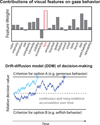From faces to prosocial behavior: cues, tools, and mechanisms
- PMID: 28943722
- PMCID: PMC5608038
- DOI: 10.1177/0963721417694656
From faces to prosocial behavior: cues, tools, and mechanisms
Abstract
In this review we ask how looking at people's faces can influence prosocial behaviors towards them. Components of this process have often been studied by disparate literatures: one focused on perception and judgment of faces, using both psychological and neuroscience approaches; and a second focused on actual social behaviors, as studied in behavioral economics and decision science. Bridging these disciplines requires a more mechanistic account of how processing of particular face attributes or features influences social judgments and behaviors. Here we review these two lines of research, and suggest that combining some of their methodological tools can provide the bridging mechanistic explanations.
Keywords: altruism; drift-diffusion model; eyetracking; face perception; social judgments.
Figures


References
-
- Adolphs R, Gosselin F, Buchanan TW, Tranel D, Schyns P, Damasio AR. A mechanism for impaired fear recognition after amygdala damage. Nature. 2005;433(7021):68–72. - PubMed
-
- Adolphs R, Tranel D, Damasio AR. The Human Amygdala in Social Judgment. Nature. 1998;393:470–474. - PubMed
-
- Adolphs R, Tranel D, Damasio H, Damasio A. Impaired recognition of emotion in facial expressions following bilateral damage to the human amygdala. Nature. 1994;372:669–672. - PubMed
-
- Bonnefon JF, Hopfensitz A, De Neys W. The modular nature of trustworthiness detection. J Exp Psychol Gen. 2013;142:143–150. - PubMed
Grants and funding
LinkOut - more resources
Full Text Sources
Other Literature Sources
